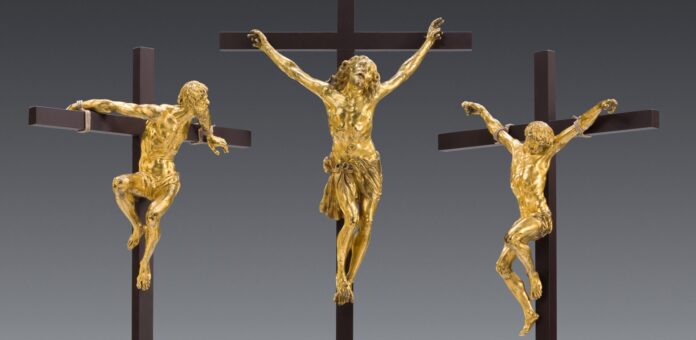The studio exhibition solves an enthralling mystery regarding the work of renowned Augsburg Baroque sculptor Georg Petel. It presents a spectacular reconstruction of his gilded Crucifixion group comprising a rendering of Christ on the cross from the Bayerisches Nationalmuseum in Munich, which was previously thought to be lost, and his masterfully crafted thieves from the Bode-Museum in Berlin.
In 1927, the Berlin Skulpturensammlung acquired two masterfully crafted, bronze-cast figures of the two thieves Dismas and Gestas, who were crucified alongside Christ, rendered by the brilliant South German Baroque sculptor Georg Petel (1601/02–1634). At the time of purchase, however, the most important part of the ensemble – the Corpus Christi nailed to the cross – was missing, and was assumed to be lost.
Discovery of a Bronze Crucifix
Recently, a surprise discovery was made in the depot of the Bayerisches Nationalmuseum in Munich: a bronze crucifix displaying a number of similarities to the two thieves housed in Berlin – the material used, the size of the piece, the condition of the fire gilding, and not least the incredible rendering of Christ’s anatomy are such a striking match that the statuette in Munich could ultimately be positively identified as the missing centre piece of Petel’s Crucifixion group. Experts were able to substantiate this attribution on the basis of art-historical stylistic criticism using sophisticated methods of technical analysis (CT scans and alloy analyses), thereby proving that all three of the figures had indeed been produced in the same workshop environment.
It was soon decided that this new discovery should be presented to the general public in the context of an exhibition – a collaboration between the Skulpturensammlung and the Museum für Byzantinische Kunst in Berlin and the Bayerisches Nationalmuseum in Munich. The small, refined exhibition presents the newly reassembled ensemble of sculptures created by the internationally renowned and well-connected Baroque sculptor in its original artistic context alongside more than a dozen works loaned to the museum from private collections in Berlin, Brussels, Munich, Weilheim, Vienna and France.
Georg Petel – The “German Michelangelo”
Georg Petel was lauded as the “German Michelangelo” well into the 18th century and is still regarded today as Germany’s first Baroque sculptor. There is no doubt that he was an outstanding figure in the German art world of the early 17th century. In his years spent travelling, the artist, who was born in Weilheim and studied both there and in Munich, first visited Antwerp, before travelling on to Rome and Genoa via Paris.
It was there that he enjoyed close creative contact with some of the most prominent artists of the day, such as Peter Paul Rubens, Anthonis van Dyck, François Duquesnoy and likely also Gian Lorenzo Bernini. This creative dialogue directly influenced his practice, and his Baroque use of forms now acquired a new level of expressive intensity. In his adoptive home of Augsburg, he became the most successful sculptor of his time, whose creations in ivory, wood and bronze set new artistic benchmarks.
Reconstructed Crucifixion Group
This concentrated view of the reunited Crucifixion group – combined with thrilling new insights into its production – offers visitors the opportunity to consider the complex artistic conditions surrounding the artwork’s conception: which exemplary works – from antiquity and Michelangelo to Petel’s contemporaries Rubens and Bernini – occupied and influenced the artist throughout his years of training and travel in an age of armed denominational conflicts and artistic innovations? All of these aspects are demonstrated and explained by Georg Petel’s Crucifixion group, which continues to dazzle viewers to this day.
The exhibition can be viewed at the Bayerisches Nationalmuseum in Munich until 30 June 2024 before it moves to the Bode-Museum on Museum Island in Berlin.
Curators
The exhibition is curated by Hans-Ulrich Kessler, curator of the Skulpturensammlung und Museum für Byzantinsche Kunst, and Jens Ludwig Burk, deputy director of the Bayerisches Nationalmuseum, Munich.
Accompanying Exhibition Publication
The exhibition catalogue, sponsored by the Ernst von Siemens Art Foundation, has already been published by Sandstein-Verlag, Dresden: 128 pages, with numerous illustrations, ISBN 978-3-95498-794-8, price: €24.
The exhibition is sponsored by the Reiner Winkler Stiftung and the Kaiser Friedrich Museumsverein.
A special presentation organised by the Skulpturensammlung und Museum für Byzantinische Kunst – Staatliche Museen zu Berlin and the Bayerisches Nationalmuseum, Munich
Source : Museen zu Berlin






